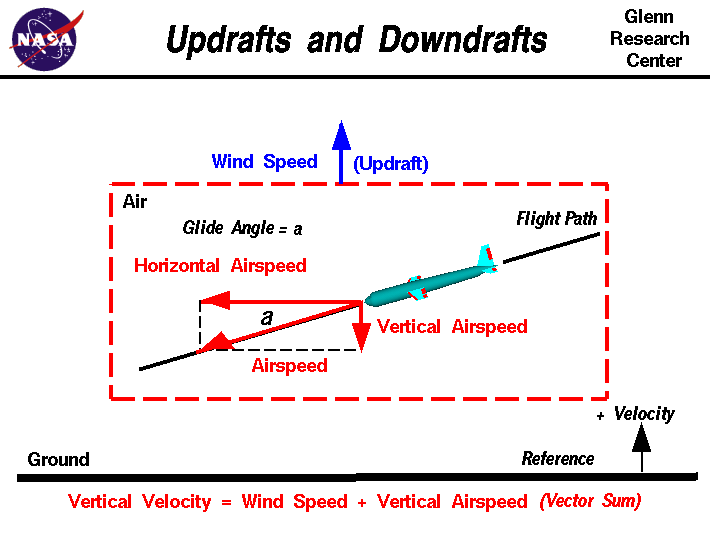
One of the most confusing concepts for young aerodynamicists is
the relative velocity between objects.
Aerodynamic forces
are generated by an object moving through the air, but the air itself can
move also. Aerodynamic forces depends on the square of the velocity
between the object and the air. To properly define the velocity, it
is necessary to pick a fixed reference point and measure velocities
relative to the fixed point. In this slide, the reference point is
fixed on the ground
The air in which the aircraft flies can move in all three
directions. In this figure, we are only considering air movement
which is perpendicular to the ground which is called an updraft,
if it is directed away from the ground, or a downdraft if it is
directed towards the ground.
The effect of air motion along
the flight path is described on another slide.
The effects of
cross winds,
which are parallel to the ground and perpendicular to updrafts and
downdrafts, are also described on another page.
On this slide, we are considering a glider
which moves through the air along a flight path at some velocity
called the airspeed. The flight path makes an angle with the
horizontal which is called the glide
angle. The airspeed can then be
resolved
into a horizontal
component and a vertical component relative to the ground plane.
For a descending glider, the vertical airspeed is
negative.
The aerodynamic forces acting on the glider are
defined relative to the flight path. The
drag acts along the flight path
while the
lift acts perpendicular
to the flight path.
The air moves at some constant velocity called the wind speed.
The wind speed is a
vector quantity
having both a magnitude and a direction.
We define an updraft to be in the positive direction and a
downdraft to be in the negative direction. The vertical
velocity of the aircraft, relative to the ground, is the
vector sum
of the vertical airspeed and the wind speed.
Vertical Velocity = Vertical Airspeed + Wind Speed
If the magnitude of
an updraft is greater than the magnitude of the vertical airspeed, a
glider can gain altitude even though it is always falling through the
surrounding air !! The air rises faster than the glider falls.
Similarly, a strong downdraft can cause an aircraft to lose altitude
even though it may be climbing through the surrounding air.
Updrafts are found when a wind blowing at a hill or mountain has
to rise to climb over the hill.
Updrafts can also be caused by the sun
heating
the ground. The heat from the ground warms the
surrounding air, which causes the air to rise. The rising pockets of
hot air are called thermals.
Downdrafts occur on the downwind side of a hill or mountain.
Downdrafts are often found in the vicinity of strong thunderstorms. A
micro-burst is a highly localized downdraft of air.
Micro-bursts near airports have been blamed for airplane crashes
in recent years.
The description given for this slide concerns static
performance only. This means that the wind is steady and the
aircraft is aligned along its flight path. Unsteady updrafts or
downdrafts introduce additional forces on the aircraft due to
instantaneous changes in the angle of attack. Additional forces can
also be generated by maneuvering, the aircraft
along the flight path by using the elevator. These effects are not
discussed in this slide.
Activities:
Guided Tours
-
 Gliding Flight:
Gliding Flight:

-
 Into the Wind:
Into the Wind:

Navigation ..

- Beginner's Guide Home Page
|
